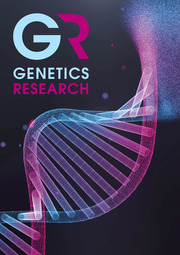Crossref Citations
This article has been cited by the following publications. This list is generated based on data provided by Crossref.
Shin, Hee-Sup
Stavnezer, Janet
Artzt, Karen
and
Bennett, Dorothea
1982.
Genetic structure and origin of t haplotypes of mice, analyzed with H-2 cDNA probes.
Cell,
Vol. 29,
Issue. 3,
p.
969.
Tres, Laura L.
and
Erickson, Robert P.
1982.
Electron microscopy of t-allele synaptonemal complexes discloses no inversions.
Nature,
Vol. 299,
Issue. 5885,
p.
752.
Sturm, Sabine
Figueroa, Felipe
and
Klein, Jan
1982.
The relationship between t and H-2 complexes in wild mice: I. The H-2 haplotypes of 20 t-bearing strains.
Genetical Research,
Vol. 40,
Issue. 1,
p.
73.
Andrews, P.W.
and
Goodfellow, P.N.
1982.
Analysing the mouse T/t complex.
Nature,
Vol. 299,
Issue. 5881,
p.
296.
Olds-Clarke, Patricia
1983.
Nonprogressive sperm motility is characteristic of most completethaplotypes in the mouse.
Genetical Research,
Vol. 42,
Issue. 2,
p.
151.
Artzt, Karen
1983.
Ciba Foundation Symposium 96 ‐ Fetal Antigens and Cancer.
Vol. 96,
Issue. ,
p.
55.
Gill, Thomas J.
Siew, Shirley
and
Kunz, Heinz W.
1983.
Major histocompatibility complex (MHC)‐linked genes affecting development.
Journal of Experimental Zoology,
Vol. 228,
Issue. 2,
p.
325.
Condamine, Hubert
Guénet, Jean-Louis
and
Jacob, François
1983.
Recombination between two mouset-haplotypes (tw12tfandtLub-1): segregation of lethal factors relative to centromere and tufted (tf) locus.
Genetical Research,
Vol. 42,
Issue. 3,
p.
335.
Klein, Jan
Sipos, Peter
and
Figueroa, Felipe
1984.
Polymorphism of t-complex genes in European wild mice.
Genetical Research,
Vol. 44,
Issue. 1,
p.
39.
Balber, A. E.
Amos, D. B.
and
Artzt, Karen
1984.
H ‐ 2 ANTIGENS OF CERTAIN t AND NON‐t MICE REACT WITH THE SAME MONOCLONAL ANTIBODY.
International Journal of Immunogenetics,
Vol. 11,
Issue. 2,
p.
127.
Sánchez, Edwin R.
and
Erickson, Robert P.
1985.
Expression of the Tcp-1 locus of the mouse during early embryogenesis.
Development,
Vol. 89,
Issue. 1,
p.
113.
Lenington, Sarah
and
Egid, Kathleen
1985.
Female discrimination of male odors correlated with male genotype at the T locus: A response to T-locus or H-2-locus variability?.
Behavior Genetics,
Vol. 15,
Issue. 1,
p.
53.
Willison, Keith R.
Dudley, Keith
and
Potter, Jean
1986.
Molecular cloning and sequence analysis of a haploid expressed gene encoding t complex polypeptide 1.
Cell,
Vol. 44,
Issue. 5,
p.
727.
Gachelin, Gabriel
Delarbre, Christiane
and
Morita, Takashi
1986.
Evolutionary Processes and Theory.
p.
115.
Martin, Gail R.
Silver, Lee M.
Fox, Howard S.
and
Joyner, Alexandra L.
1987.
Establishment of embryonic stem cell lines from preimplantation mouse embryos homozygous for lethal mutations in the t-complex.
Developmental Biology,
Vol. 121,
Issue. 1,
p.
20.
Artzt, Karen
Barlow, Denise
Dove, William F.
Fischer-Lindahl, Kirsten
Klein, Jan
Lyon, Mary F.
and
Silver, Lee M.
1991.
Mouse chromosome 17.
Mammalian Genome,
Vol. 1,
Issue. S1,
p.
S280.
FUJIMOTO, Atsushi
BABA, Nobuyuki
and
WAKASUGI, Noboru
1991.
A tail length modifier gene discovered in the Japanese wild mice (Mus musculus molossinus)..
The Japanese Journal of Genetics,
Vol. 66,
Issue. 2,
p.
141.
Klein, Jan
1991.
Maps of mouse chromosome 17: First report.
Mammalian Genome,
Vol. 1,
Issue. 1,
p.
5.
Lenington, Sarah
1991.
Vol. 20,
Issue. ,
p.
51.
Silver, Lee M.
Artzt, Karen
Barlow, Denise
Fischer-Lindahl, Kirsten
Lyon, Mary F.
Klein, Jan
and
Snyder, Linda
1992.
Mouse Chromosome 17.
Mammalian Genome,
Vol. 3,
Issue. S1,
p.
S241.

